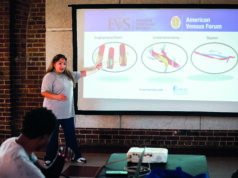
Overall survival improved from 71% to 80% after a group of community practice surgeons started using an endovascular-first approach to ruptured abdominal aortic aneurysm (rAAA) repair.
Scott S. Berman, MD, a vascular surgeon at Pima Heart & Vascular in Tucson, Arizona, revealed the finding during a rapid-fire presentation offering a look at his practice’s experience with rAAAs in the private community setting during the Western Vascular Society (WVS) annual meeting in Jackson Hole, Wyoming (Oct. 16–19).
Berman and colleagues carried out a retrospective review of their prospectively collected Society for Vascular Surgery (SVS) Vascular Quality Initiative (VQI) data, pointing out the unusual nature of the community practice-setting metric.
Against a backdrop of rAAA mortality rates running as high as 50%, Berman said his research team looked at their practice during two distinct periods: from January 2011 to December 2015 (group one) prior to the adoption of an endovascular aneurysm repair (EVAR)-first approach to rAAA, and from January 2016 to December 2020 (group two), after the move to adopt an EVAR-first protocol.
The researchers analyzed open repairs and EVARs carried out over the two periods, scrutinizing data elements common to both and undertaking comparisons with univariate and multivariate analyses.
The data showed 10% of the 456 aneurysm repairs his practice undertook were rAAAs—equating to 41 overall, Berman reported. With 21 repairs completed in group one and 20 in group two, the results showed a survival rate of 67% vs. 88% for EVAR and 73% vs. 33% for open repair over the two time periods. Furthermore, overall survival was 71% vs. 80% between groups one and two, Berman told WVS attendees.
“You can see there is definitely an improvement in survival with the endovascular approach,” Berman commented. “In group two, we did 17 vs. three open compared to group one [which saw 15 open vs. six EVAR]. We had decent long-term follow-up at 12 months [76% overall; and 82% in group one vs. 75% in group two] with pretty good survival as well. Despite a lot of positive trends with our survival rate, the only variable that was statistically significant was ICU [intensive care unit] stay greater than three days, which was much higher with open repair (p<0.05). We had some trends: The probability of death was higher with open repair; time to extubation was higher with open repair; and any post-op complication was higher with open repair.”
Berman concluded: “Our outcomes with an endovascular-first approach are certainly superior to historically quoted outcomes for rAAA. The real challenge is defining an appropriate center of excellence for management of ruptured aneurysms—this is certainly evolving. We think it’s pretty simple: You need a 24/7 vascular call team. You either need to have an array of devices on hand, or you have to have reps available who can provide emergency devices. And it’s really not dependent on the title of academic versus community practice. Hopefully, the combined project between the SVS and the American College of Surgeons [ACS] in defining vascular center certification will help objectively define appropriate levels of care for each center.”












